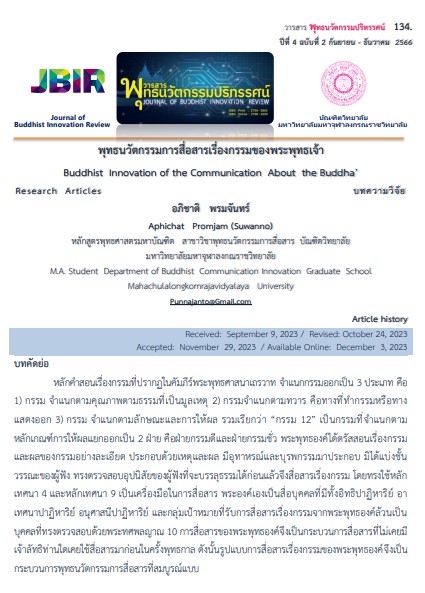BUDDHIST INNOVATION OF THE COMMUNICATION ABOUT THE BUDDHA’S KAMMA
Main Article Content
Abstract
The results of thesis showed that the doctrine of Kamma found in Theravada Buddhist scriptures can be classified into 3 types: 1) Kamma is classified by the qualities of karmic causes 2) Kamma is classified by the sense doors of deeds 3) Kamma is classified by its nature and its consequences, called "12 Kamma." Karma can be also classified by the principle of consequences: wholesome deed and unwholesome deed. The Lord Buddha had taught about Kamma and the consequences of Kamma in detail. The Buddha’s teachings consisted of cause and effect, parables and predecessors to accompany it. Buddha teaches all people without dividing the caste of the listeners. Buddha would first examine the character of the listeners who would attain enlightenment and then communicate about wholesome deed and unwholesome deed. He uses the 4 principles and the 9 principles of teaching as the tools of communication. He himself was the person who possessed 3 miracles; marvel of physicl power; marvel of mind reading and marvel of teaching. All people who listen Buddha’s teaching on Kamma have been examined by his 10 powers of perfection wisdom (Dasa-Balanana). Therefore, it is the most perfect procession of Buddhist innovative communication.
Article Details

This work is licensed under a Creative Commons Attribution-NonCommercial-NoDerivatives 4.0 International License.
เรื่องลิขสิทธิ์/เป็นความคิดเห็นของผู้เขียน
References
หนังสือ:
คณาจารย์ มหาวิทยาลัยมหาจุฬาลงกรณราชวิทยาลัย. (2559). พุทธวิธีการสอน Buddha’s Teaching
Methods. พิมพ์ครั้งที่ 2. พระนครศรีอยุธยา: โรงพิมพ์มหาจุฬาลงกรณราชวิทยาลัย.
มหาจุฬาลงกรณราชวิทยาลัย. (2535). พระไตรปิฎกภาษาบาลี ฉบับมหาจุฬาเตปิฏกํ 2500. กรุงเทพมหานคร:โรงพิมพ์มหาจุฬาลงกรณราชวิทยาลัย.
มหาจุฬาลงกรณราชวิทยาลัย. (2539). พระไตรปิฎกภาษาไทย ฉบับมหาจุฬาลงกรณราชวิทยาลัย. กรุงเทพมหานคร: โรงพิมพ์มหาจุฬาลงกรณราชวิทยาลัย.
มหาจุฬาลงกรณราชวิทยาลัย. (2560). อรรถกถาภาษาไทย ฉบับมหาจุฬาลงกรณราชวิทยาลัย. กรุงเทพมหานคร: โรงพิมพ์มหาจุฬาลงกรณราชวิทยาลัย.
สมเด็จพระพุฒาจารย์ (อาจ อาสภมหาเถร). (2554). คัมภีร์วิสุทธิมรรค. พิมพ์ครั้งที่ 10. กรุงเทพมหานคร: บริษัท ธนาเพลส จำกัด.
สมเด็จพระพุทธโฆษาจารย์ (ป.อ.ปยุตฺโต). (2562). พุทธธรรม (ฉบับปรับขยาย). พิมพ์ครั้งที่ 53 (ฉบับข้อมูลคอมพิวเตอร์ ครั้งที่ 22). จันทบุรี: โรงพิมพ์ทบพัน.
สมเด็จพระพุทธโฆษาจารย์ (ป.อ.ปยุตฺโต). พจนานุกรมพุทธศาสตร์ ฉบับประมวลธรรม. พิมพ์ครั้งที่ 19, นนทบุรี: โรงพิมพ์ เอส.อาร์.พริ้นติ้ง แมส โปรดักส์ จำกัด.
สมเด็จพระพุทธโฆษาจารย์ (ป.อ.ปยุตฺโต). (2563). พจนานุกรมพุทธศาสน์ ฉบับประมวลศัพท์. พิมพ์ครั้งที่ 34. กรุงเทพมหานคร: สำนักพิมพ์ผลิธัมม์, 2563.
สำนักงานแม่กองธรรมสนามหลวง. หลักสูตรธรรมศึกษาชั้นตรี ฉบับปรับปรุง. กรุงเทพมหานคร: โรงพิมพ์สำนักงานพระพุทธศาสนาแห่งชาติ.
สื่ออิเล็กทรอนิกส์
พจนานุกรม ฉบับราชบัณฑิตยสถาน พ.ศ.2554. ระบบค้าหาศัพท์. [ออนไลน์]. แหล่งที่มา: www. dictionary.orst.go.th. (วันที่สืบค้น 30 ธันวาคม 64).
สำนักงานสถิติแห่งชาติ. สำรวจด้านสังคม สาขาศาสนาศิลปะวัฒนธรรม. [ออนไลน์]. แหล่งที่มา: www.nso.go.th. (วันที่สืบค้น 13 ตุลาคม 2564.


